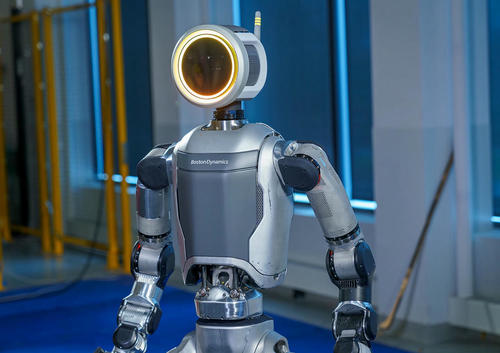See on Scoop.it - Design, Science and Technology

“Teens are opening up to chatbots on Character.AI as a way to explore friendship. But some chatbots, like Psychologist, offer more guidance than they’re qualified to …”
At the time, it seemed like the end of the world. “I used to cry every night,” said Aaron, who lives in Alberta, Canada. (The Verge is using aliases for the interviewees in this article, all of whom are under 18, to protect their privacy.)
Eventually, Aaron turned to his computer for comfort. Through it, he found someone that was available round the clock to respond to his messages, listen to his problems, and help him move past the loss of his friend group. That “someone” was an AI chatbot named Psychologist.
The chatbot’s description says that it’s “Someone who helps with life difficulties.” Its profile picture is a woman in a blue shirt with a short, blonde bob, perched on the end of a couch with a clipboard clasped in her hands and leaning forward, as if listening intently.
Read the full article at: www.theverge.com
See on Scoop.it - Design, Science and Technology

“Tried and tested: These AI image generators consistently delivered the best results. Here’s a look at how they work, how much they cost, and how they handled a specific prompt …”
The use of AI to generate weird and wonderful imagery is definitely my favorite application of the cutting-edge tech.
I’ve tested outAI writing toolsandAI productivity tools, but putting the host of AI image generators through their paces was hands-down the most fun I’ve had in testing tools in ages (and Ilovetesting tools).
As with other AI tools, there’s no shortage of artificial intelligence image generators in the market. I’m sure by the time this article is published, about 35 more will have just launched that I’ll need to test.
By now, we all know that AI image generators can come up with all sorts of fantastical, eclectic imagery. But since you’re reading the Buffer blog, I’m going to be presumptuous and assume you’re either in marketing, a small business owner, or a creator — and you’re probably looking for a tool that can do something you can actually use in your work.
Read the full article at: buffer.com
See on Scoop.it - Design, Science and Technology

NASA’s Innovative Advanced Concepts program (NIAC) has selected six visionary concept studies for additional funding and development. Each study has already completed the initial NIAC phase, showing their futuristic ideas – like a lunar railway system and fluid-based telescopes – may provide fresh perspectives and approaches as NASA explores the unknown in space.
The NIAC Phase II conceptual studies will receive up to $600,000 to continue working over the next two years to address key remaining technical and budget hurdles and pave their development path forward. When Phase II is complete, these studies could advance to the final NIAC phase, earning additional funding and development consideration toward becoming a future aerospace mission.
“These diverse, science fiction-like concepts represent a fantastic class of Phase II studies,” said John Nelson, NIAC program executive at NASA Headquarters in Washington. “Our NIAC fellows never cease to amaze and inspire, and this class definitely gives NASA a lot to think about in terms of what’s possible in the future.”
The six concepts chosen for 2024 NIAC Phase II awards are:
- Fluidic Telescope (FLUTE): Enabling the Next Generation of Large Space Observatories would create a large optical observatory in space using fluidic shaping of ionic liquids. These in-space observatories could potentially help investigate NASA’s highest priority astrophysics targets, including Earth-like exoplanets, first-generation stars, and young galaxies. The FLUTE study is led by Edward Balaban from NASA’s Ames Research Center in California’s Silicon Valley.
- Pulsed Plasma Rocket: Shielded, Fast Transits for Humans to Mars is an innovative propulsion system that relies on using fission-generated packets of plasma for thrust. This innovative system could significantly reduce travel times between Earth and any destination in the solar system. This study is led by Brianna Clements with Howe Industries in Scottsdale, Arizona.
- The Great Observatory for Long Wavelengths (GO-LoW) could change the way NASA conducts astronomy. This mega constellation low-frequency radio telescope uses thousands of autonomous SmallSats capable of measuring the magnetic fields emitted from exoplanets and the cosmic dark ages. GO-LoW is led by Mary Knapp with MIT in Cambridge, Massachusetts.
- Radioisotope Thermoradiative Cell Power Generator is investigating new in-space power sources, potentially operating at higher efficiencies than NASA legacy power generators. This technology could enable small exploration and science spacecraft in the future that are unable to carry bulky solar or nuclear power systems. This power generation concept study is from Stephen Polly at the Rochester Institute of Technology in New York.
- FLOAT: Flexible Levitation on a Track would be a lunar railway system, providing reliable, autonomous, and efficient payload transport on the Moon. This rail system could support daily operations of a sustainable lunar base as soon as the 2030s. Ethan Schaler leads FLOAT at NASA’s Jet Propulsion Laboratory in Southern California.
- ScienceCraft for Outer Planet Exploration distributes Quantum Dot-based sensors throughout the surface of a solar sail, enabling it to become an innovative imager. Quantum physics would allow NASA to take scientific measurements through studying how the dots absorb light. By leveraging the solar sail’s area, it allows lighter, more cost-effective spacecraft to carry imagers across the solar system. ScienceCraft is led by NASA’s Mahmooda Sultana at the agency’s Goddard Space Flight Center in Greenbelt, Maryland.
NASA’s Space Technology Mission Directorate funds the NIAC program, as it is responsible for developing the agency’s new cross-cutting technologies and capabilities to achieve its current and future missions.
Read the full article at: www.nasa.gov
See on Scoop.it - Design, Science and Technology

“While it’s easy to show that people differ in navigational ability, it has proved much harder for scientists to explain why. There’s new excitement brewing in the navigation research world, though. By leveraging technologies such as virtual reality and GPS tracking, scientists have been able to watch hundreds, sometimes even millions, of people trying to find their way through complex spaces, and to measure how well they do. Though there’s still much to learn, the research suggests that to some extent, navigation skills are shaped by upbringing.”
Read the full article at: knowablemagazine.org
See on Scoop.it - Design, Science and Technology

Much as ChatGPT generates poetry, a new A.I. system devises blueprints for microscopic mechanisms that can edit your DNA.
Generative A.I. technologies can write poetry and computer programs or create images of teddy bears and videos of cartoon characters that look like something from a Hollywood movie.
Now, new A.I. technology is generating blueprints for microscopic biological mechanisms that can edit your DNA, pointing to a future when scientists can battle illness and diseases with even greater precision and speed than they can today.
Read the full article at: www.nytimes.com
See on Scoop.it - Design, Science and Technology

“Soulless avatars might end up driving folks away in the end …”
Catholic Answers is a “media ministry that serves Christ by explaining and defending the Catholic faith,” according to their description on X. For Catholic observers, it serves as a good resource for deepening one’s faith and finding clarification on certain Catholic doctrines. However, the site recently introduced a controversial new member to the team: Father Justin, a chatbot “priest” designed to help answer people’s questions about Catholicism. In defense of this AI app, Catholic Answers said,
As a leading Catholic apostolate, Catholic Answers is committed to leveraging the latest technologies to advance its mission of explaining and defending the Catholic faith. The Father Justin app is the latest example of this commitment, providing a new and appealing way for searchers to begin or continue their journey of faith.
Read the full article at: mindmatters.ai
See on Scoop.it - Design, Science and Technology

“AI music generators — AIs that create new music based on users’ text prompts — are lowering the bar for music creation, for better or worse …”
On April 10, a new release shook the world of music.
No, it wasn’t a new Frank Ocean album or even another Drake diss track (more on those later). This drop wasn’t actually a new piece of music at all. It was Udio, an app that uses AI to generate music from users’ text prompts — think ChatGPT for instrumentals.
Though not the first product of its kind, Udio is arguably the best of the bunch — so how exactly does it work, and what could it mean for the future of music?
Read the full article at: www.freethink.com
See on Scoop.it - Design, Science and Technology

“United has bet heavily on the cloud and is now looking how to optimize its cloud usage …”
When you board a United Airlines plane, the gate agents, flight attendants and others involved in making sure your plane leaves on time are in a chatroom coordinating a lot of the work that you, as a passenger, will hopefully never notice. Is there still space for carry-on bags? Did the caterer bring the missing orange juice? Is there a way to seat a family together?
When a flight is delayed, a message with an explanation will arrive by text and in the United app. Most of the time, that message is generated by AI. Meanwhile, in offices around the world, dispatchers are looking at this real-time data to ensure that the crew can still legally fly the plane without running afoul of FAA regulations. And only a few weeks ago, United turned on its AI customer service chatbot.
Read the full article at: techcrunch.com
See on Scoop.it - Design, Science and Technology
Proving geometric theorems constitutes a hallmark of visual reasoning combining both intuitive and logical skills. Therefore, automated theorem proving of Olympiad-level geometry problems is considered a notable milestone in human-level automated reasoning. The introduction of AlphaGeometry, a neuro-symbolic model trained with 100 million synthetic samples, marked a major breakthrough. It solved 25 of 30 International Mathematical Olympiad (IMO) problems whereas the reported baseline based on Wu’s method solved only ten.
In this paper, the IMO-AG-30 Challenge introduced with AlphaGeometry was revisited, and the researchers found that Wu’s method is surprisingly strong. Wu’s method alone can solve 15 problems, and some of them are not solved by any of the other methods. This leads to two key findings: (i) Combining Wu’s method with the classic synthetic methods of deductive databases and angle, ratio, and distance chasing solves 21 out of 30 methods by just using a CPU-only laptop with a time limit of 5 minutes per problem. Essentially, this classic method solves just 4 problems less than AlphaGeometry and establishes the first fully symbolic baseline, strong enough to rival the performance of an IMO silver medalist. (ii) Wu’s method even solves 2 of the 5 problems that AlphaGeometry failed to solve. Thus, by combining AlphaGeometry with Wu’s method a new state-of-the-art for automated theorem proving on IMO-AG-30, solving 27 out of 30 problems, the first AI method which outperforms an IMO gold medalist is finally achieved.
Read the full article at: arxiv.org
See on Scoop.it - Design, Science and Technology

The electric version of Atlas will be stronger, with a broader range of motion than any of our previous generations. For example, our last generation hydraulic Atlas (HD Atlas) could already lift and maneuver a wide variety of heavy, irregular objects; we are continuing to build on those existing capabilities and are exploring several new gripper variations to meet a diverse set of expected manipulation needs in customer environments.
Learn more / En savoir plus / Mehr erfahren:
https://www.scoop.it/t/21st-century-innovative-technologies-and-developments/?&tag=Robotics
Read the full article at: bostondynamics.com









